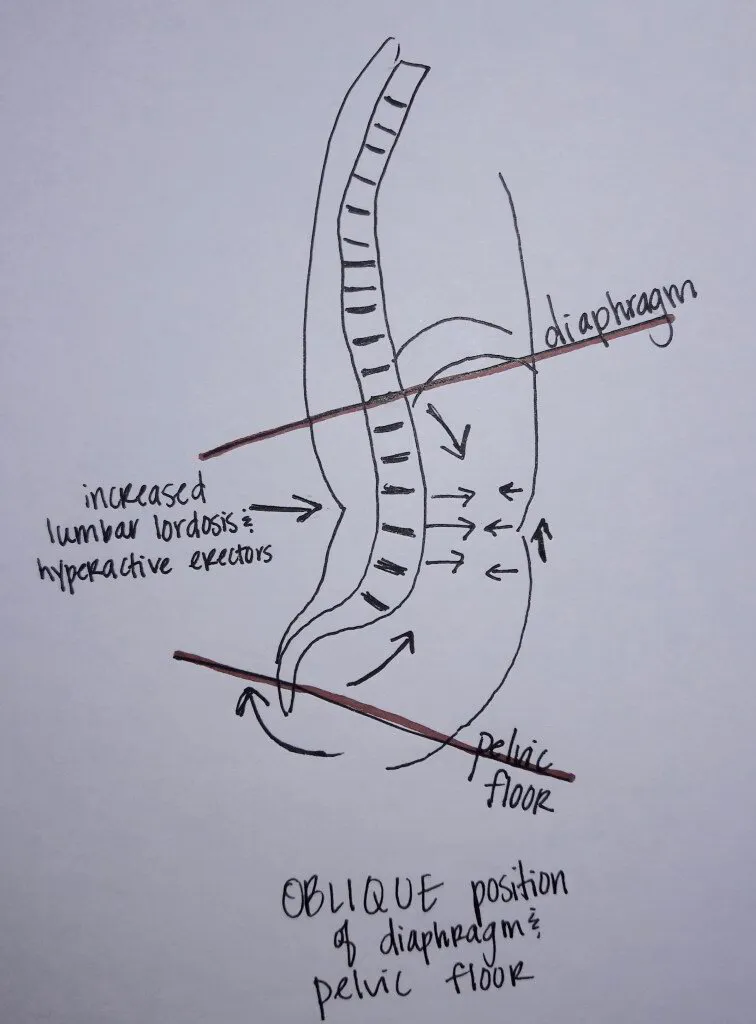This post was originally published on https://drlaurenkeller.com/understanding-the-different-breathing-options/ and has been formatted for this blog with the author’s permission.
When researching pregnancy and postpartum breathing as well as proper breathing when lifting, we run across three main types of breathing- abdominal hallowing, piston breathing, and diaphragmatic breathing. Each have their pros and cons and which is why understanding the different breathing options is an important aspect in knowing WHY we are doing something (#knowbetterdobetter).
Why the breath matters
Breathing matters because the breath is the key to a strong and stable core and body is the ability to create pressure, specifically intra-abdominal pressure (IAP), within the abdomen. IAP is fundamental in the initiation, control and prevention of movement.
Want the science on why Intra-Abdominal pressure is a GOOD thing, check the previous blog post, “For the love of all things good, stop sucking in.”
Abdominal Hallowing / Sucking-In / Belly Button to Spine
Abdominal hallowing was previously mentioned in this blog but here’s a quick breakdown…
Pros:
- Activates the transverse abdominis
Cons:
- Isolates the transverse abdominis through concentric contraction and separates the diaphragm and pelvic floor
- Inhibits activation of abdominal oblique musculature
- Sub-optimally strengthens the abdominal musculature through concentric contraction
- Creates oblique position of diaphragm and pelvic floor (see consequences of less than optimal breathing below)
- Not replicated in any functional movement
Piston Breathing
Pros:
- Helps one connect with the pelvic floor
- A great start: more beneficial long-term than abdominal hallowing and chest breathing as it focuses on trying to connect the diaphragm and pelvic floor
- Focuses on proper posture/alignment as well as breathing
- Pulls the breath out of the chest and into the belly, which is where one wants/needs to breath
Cons:
- Piston breathing implies unidirectional pressure with tight sides…when taught it typically includes something along the lines of “we quickly and forcefully draw the breath into the belly”
- This is not functional as one does not isometrically contract to breathe and move throughout the day
- The breath should never be “forceful”
- The pelvic floor and diaphragm should never be working separate of the abdominal musculature as this can create additional dysfunction
- One does not want to tighten the abdominal musculature in preparation of the inhalation as this separates the co-contraction activation that should occur
- The breath should create an eccentric activation of the abdominal muscles which then allows the muscles to tighten/loosen as they need in order to regulate the internal pressure
Diaphragmatic Breathing
Pros:
- The diaphragm, all abdominal musculature and the pelvic floor co-contract in coordination to create appropriate intra-abdominal pressure (IAP)
- IAP is what gives one strength and stabilizes the core to protect the spine from injury
- Coordinated co-contraction keeps the pelvic floor, diaphragm and musculature working in unison, which is the basis for optimal breathing (see below consequences of less than optimal breathing) (6, 7)
- Optimal movements – if you want to strengthen the glute med you would pick a single-leg deadlift over a clam shell, the diaphragm is no different
- Creates 360 degrees of expansion to stabilize the abdominal musculature, back musculature and pelvic floor
- Focuses on proper posture in both standing and seated position (4, 5, 13)
- Replicated in day-to-day function
Cons:
- It may initially feel forced until the proper breathing patterns are learned
- The goal is to make the breath more automatic/reflexive and a habit…when initially learning to do diaphragmatic breathing, it may feel a little forced as one is not accustomed to breathing in this manner and it takes time to train the proper breathing mechanics
- It may be difficult to learn due to compensation that has been trained throughout the years
- One way to help learn the breathing easier is to utilize the Core360 belt which helps one activate their core correctly and consistently
Consequences of less than optimal breathing
Less than optimal breathing often leads to a functional cascade of complications/pain or faulty movement patterns. Some of those consequences include:
- Oblique position of diaphragm & pelvic floor which can create/may lead to:The negative effects of dysfunctional breathing include an anteverted pelvis, increased lumbar lordosis, hyperactive erectors, diastasis recti, and urinary incontinence.
- Increased lumbar lordosis and increased intra-fiscal pressure: more likely to ave back pain or disc injury, chronic back tightness and hyperactivity of lumbar erectors
- Lumbopelvic and hip instability : hamstring pain with bending and sitting, trigger points in low back, buttock and upper hamstring (14, 15, 16)
- Anteverted pelvis: can lead to butt-wink in squat (8, 9, 10)
- Poor thoracic extension and scapular stability: more likely to have shoulder and upper back/neck pain
- Non-coordinated co-contraction of diaphragm, pelvic floor and abdominal musculature:Weak abdominals: the abdominal wall does not offer resistance to the diaphragm contraction which does not allow for appropriate IAP
- Tight abdominals: the abdominal wall is too tight and the diaphragm and lower ribs cannot move downward to create ideal diaphragm activation and IAP
- Secondary effects:
- Pelvic organ prolapse and urinary/fecal incontinence (3, 11)
- Often caused by a lack of tonic support and muscular strength of the pelvic floor, core and surrounding pelvic girdle musculature (1)
- Increased risk of diastasis recti
- Increased risk of disc herniation (14, 15)
- Upper back and neck pain (18)
Benefits of proper diaphragmatic breathing
- Improves core stability
- Coordinates and strengthens all components of the deep core musculature – pelvic floor muscles, transverse abdominals, multifidi, and diaphragm (2)
- Contracting the diaphragm increases intra-abdominal pressure and generates a co-contraction of the pelvic floor muscles (pubococcygeus, puborectalis, and iliococcygeus) and transverse abdomens (17)
- Decreased neck and shoulder pain (21)
- Improved function of Sternocleidomastoid muscle which may decrease ringing in the ear (19)
- Decreased use of pectoralis and scalenes which are commonly recruited in faulty breathing patterns (20)
- Improved ventilation of the lungs (22, 23)
- Increasing the inspiratory volume naturally increases the level of oxygen in the blood
- Maximize the diaphragm’s efficiency in performing breathing activity
Lauren Keller, DC, DABCA
BIRTHFIT Chicago: Western Suburbs
Instagram: @birthfit_chicago_western_burbs
Facebook: @birthfitchicago
References:
- Sapsford R. Rehabilitation of pelvic floor muscles utilizing trunk stabilization. Man Ther. 2004;9(1):3-12.
- Lee DG. The Pelvic Girdle: An integration of clinical expertise and research, 4e. Churchill Livingstone; 2010.
- Wei, J.T. and DeLancey, J.O. Functional anatomy of the pelvic floor and lower urinary tract. Clin Obstet Gynecol. 2004; 47: 3–17
- Sapsford RR, Richardson CA, Maher CF, Hodges PW. Pelvic floor muscle activity in different sitting postures in continent and incontinent women. Arch Phys Med Rehabil. 2008;89(9):1741-1747.15.
- Sapsford R. R., Hodges P. W., Richardson C. A., et al. Co-activation of the abdominal and pelvic floor muscles during voluntary exercises. Neurourology and Urodynamics. 2001;20(1):31–42.
- Bø K. Urinary incontinence, pelvic floor dysfunction, exercise and sport. Sports Medicine. 2004;34(7):451–464. doi: 10.2165/00007256-200434070-00004.
- Pereira L. C., Botelho S., Marques J., et al. Are transversus abdominis/oblique internal and pelvic floor muscles coactivated during pregnancy and postpartum? Neurourology and Urodynamics. 2013;32(5):416–419. doi: 10.1002/nau.22315.
- Soljanik I., Janssen U., May F., et al. Functional interactions between the fossa ischioanalis, levator ani and gluteus maximus muscles of the female pelvic floor: a prospective study in nulliparous women. Archives of Gynecology and Obstetrics. 2012;286(4):931–938. doi: 10.1007/s00404-012-2377-4.
- Capson A. C., Nashed J., Mclean L. The role of lumbopelvic posture in pelvic floor muscle activation in continent women. Journal of Electromyography and Kinesiology. 2011;21(1):166–177. doi: 10.1016/j.jelekin.2010.07.017.
- Cerruto M. A., Vedovi E., Mantovani W., D’Elia C., Artibani W. Effects of ankle position on pelvic floor muscle electromyographic activity in female stress urinary incontinence: preliminary results from a pilot study. Archivio Italiano di Urologia e Andrologia. 2012;84(4):184–188.
- Halski T., Słupska L., Dymarek R., et al. Evaluation of bioelectrical activity of pelvic floor muscles and synergistic muscles depending on orientation of pelvis in menopausal women with symptoms of stress urinary incontinence: a preliminary observational study. BioMed Research International. 2014;2014:8. doi: 10.1155/2014/274938.274938
- Devreese A., Staes F., Janssens L., Penninckx F., Vereecken R., de Weerdt W. Incontinent women have altered pelvic floor muscle contraction patterns. The Journal of Urology. 2007;178(2):558–562. doi: 10.1016/j.juro.2007.03.097.
- Chmielewska D, Stania M, Sobota G, et al. Impact of Different Body Positions on Bioelectrical Activity of the Pelvic Floor Muscles in Nulliparous Continent Women. BioMed Research International. 2015;2015:905897. doi:10.1155/2015/905897.
- Hebert JJ, Koppenhaver SL, Magel JS, Fritz JM. The relationship of transversus abdominis and lumbar multifidus activation and prognostic factors for clinical success with a stabilization exercise program: a cross-sectional study. Arch Phys Med Rehabil. 2010;91(1):78-85
- Cholewicki J, Silfies SP, Shah RA, et al. Delayed trunk muscle reflex responses increase the risk of low back injuries. Spine (Phila Pa 1976). 2005;30:2614-2620
- Holmich P, Larsen K, Krogsgaard K, Gluud C. Exercise program for prevention of groin pain in football players: a cluster-randomized trial. Scand J Med Sci Sports. 2010;20:814-821
- Akuthota V, Nadler SF. Core strengthening. Arch Phys Med Rehabil. 2004;85(3)(suppl 1):S86-S92
- Ingraham, Paul. The Respiration Connection: How breathing might be a root cause of a variety of common upper body pain problems and injuries. PainScience.com. updated September 13, 2016 (published 2005).
- Travell J, Simons D, Simons L. Myofascial Pain and Dysfunction: The Trigger Point Manual. 2nd ed. Lippincott, Williams & Wilkins; 1999. p314.
- Magee DJ. Orthopedic physical assessment. WB Saunders Company; 1997. pp219-221.
- Padula CA, Yeaw E. Inspiratory muscle training: integrative review. Research & Theory For Nursing Practice. 2006 Winter;20(4):291–304.
- Kolar P, Neuwirth J, Sanda J, Suchanek V, Svata Z, Volejnik J, Pivec M. Analysis of diaphragm movement during tidal breathing and its during activation while breath holding using MRI synchronized with Spirometry. Physiol Res 2009;58:383-92
- Kolar P, Sulc J, Kyncl M, Sanda J, Neuwirth J, Bokarius AV, Kriz J, Kobesova A. J Applied Physiol Aug 2010
Get Started
Effective programs for both MIND ⊕ BODY
This is a general strength and conditioning program for women in all seasons and cycles of life. You receive four workouts each week with options for those with limited equipment and variations on movements.
Start moving and training with your cycle ❤︎
Slow is Fast when you heal your core and pelvic floor from the inside out by starting with breath work, natural movement patterns, and continue to progressively build upon a solid foundation. The number one referral for doctors and midwives.
Are you open to conception? Join us in B! Community training. A general strength and conditioning for women that train while honoring their menstrual cycle. Everyone is in a different part of their journey, we support you where you are.
Do Pregnancy Different, when you connect with your body daily through a safe, effective prenatal training program for all levels and all fitness backgrounds that includes core and pelvic floor prehab, mobility, strength, and conditioning.






